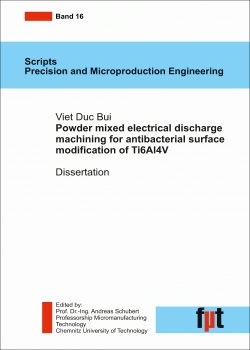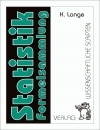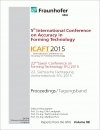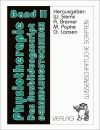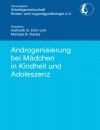|
→ Inhaltsverzeichnis  → Leseprobe → Leseprobe 
Andreas Schubert (Hrsg.)
Viet Duc Bui
Powder mixed electrical discharge machining for antibacterial surface modification of Ti6Al4V
Scripts Precision and Microproduction Engineering, Band 16
176 Seiten, A5, Broschur
ISBN: 9783957351562
Verlag Wissenschaftliche Scripten
Abstract
Within the scope of this work, powder mixed electrical discharge machining (PMEDM) is studied to enable simultaneous ablative shaping and surface modification for a generation of an e ective-antibacterial layer on the implant surface. Comprehensive evaluations in sinking and milling operations have shown that PMEDM can deposit silver from silver nano-powders suspended in the dielectric medium onto and into the modified layer. The silver deposition is significantly a ected by discharge energy, polarity, ushing strategy, size and geometry of tool electrode, and especially powder concentration. In addition, ultrasonic vibration assisted PMEDM not only enhances the uniformity of deposited silver, but also prevents a spattered layer which poses a fundamental challenge of the PMEDM process for its applicability to medical implant processing. Modified surfaces containing di erent silver contents exhibit a significant reduction of Staphylococcus aureus bacteria and no negative in influence on the attachment and di erentiation of osteoblasts. Moreover, the deposited silver content plays a vital role in the antibacterial property. A surface containing 3.78 % silver showed a significant decrease in bacterial numbers and clusters, however no further considerable reduction is obtained at higher silver contents.
Referat
Im Rahmen dieser Arbeit wurde die pulverunterstutzte Funkenerosion (eng.: powder mixed electrical discharge machining - PMEDM) erforscht, um gleichzeitig eine abtragende Formgebung sowie eine Oberflächenmodifikation zur Realisierung antibakteriell wirksamer Schichten auf Implantatoberflächen zu ermöglichen. Umfassende Untersuchungen sowohl im Senk- als auch im Bahnerosionsverfahren zeigten, dass mittels der pulverunterstützten Funkenerosion Silber aus einer Dielektrikum-Silber-Suspension auf und in die Werkstoffrandschicht abgeschieden werden kann. Die Silberabscheidung wird dabei signifikant von der Entladungsenergie, der Polarität, der Spülstrategie, der Größe und Geometrie der Werkzeugelektrode und insbesondere der Pulverkonzentration beeinflusst. Durch den Einsatz von Ultraschall-unterstutztem PMEDM wird nicht nur die Homogenität der Verteilung des abgeschiedenen Silbers verbessert, sondern auch die Bildung der wiederangelagerten Schicht, die eine grundlegende Herausforderung des PMEDM-Verfahrens bei der Bearbeitung medizinischer Implantate darstellt, verhindert. Die modifizierten Oberflächen mit unterschiedlichen Silbergehalten zeigten eine signifikante Reduzierung von Staphylococcus aureus-Bakterien und keinen negativen Einfluss auf die Anheftung und Di erenzierung der Osteoblasten. Zusätzlich hat sich gezeigt, dass der abgeschiedene Silbergehalt eine entscheidende Rolle für die antibakteriellen Eigenschaften der Bauteiloberfläche hat. So konnte festgestellt werden, dass die Oberfläche mit einem Silbergehalt von 3,78 % eine signifikante Verringerung der Bakterien- und Clusteranzahl aufweist, wobei bei höheren Silbergehalten keine weitere Reduzierung beobachtet wurde.
__________________
1 Introduction
2 State of the art
2.1 Fundamentals of Powder Mixed Electrical Discharge Machining
2.2 PMEDM for surface modification
2.2.1 Powder material
2.2.2 Powder concentration and size
2.2.3 Influence of EDM process parameters
2.2.4 Content and distribution of the transferred powder
2.2.5 Vibration assisted PMEDM
2.2.6 E ects of electrode parameters
2.3 Electrical discharge machining of Ti-6Al-4V alloy
2.4 Surface modification techniques for antibacterial e ects
2.4.1 Surface chemistry modification
2.4.2 Topography modification
2.4.3 Surface modification by antibiotic loading
2.5 Impact of surface roughness on the antibacterial e ect
2.6 Biocompatibility of the EDM surface
2.7 Summary of literature review
3 Aims of the thesis
3.1 Investigation of PMEDM process with regards to the deposited silver content and distribution
3.2 Evaluation the influence of PMEDM modified surfaces on antibacterial and biocompatible properties
4 Experimental implementation
4.1 Material selection
4.1.1 Workpiece material
4.1.2 Powder material selection
4.1.3 Tool material
4.1.4 Dielectric
4.2 PMEDM machining methodology
4.2.1 Applied EDM machine and PMEDM circulation system
4.2.2 PMEDM crater investigation
4.2.3 Investigating the influence of powder concentration
4.2.4 Investigating the influence of discharge energy
4.2.5 PMEDM using the sheet tool electrode
4.3 Investigation of ultrasonic vibration assisted PMEDM
4.3.1 Frequency and amplitude of the vibration
4.3.2 PMEDM-Sinking
4.3.3 PMEDM-Milling
4.4 In vitro antibacterial and biocompatibility investigation
4.4.1 Methodology for antibacterial tests
4.4.2 Methodology for biocompatibility Investigation
5 Results and discussion
5.1 Fundamental of silver nano-particles mixed EDM process
5.1.1 Analysis of pulse signals
5.1.2 Crater generated by a single discharge
5.2 Content and distribution of the deposited silver
5.2.1 Deposited silver distribution
5.2.2 Deposited silver content of the modified layer
5.2.3 Improving the deposited silver's uniformity by using the sheet tool electrode
5.3 Mechanism of the silver deposition to the modified layer
5.4 Surface quality analysis
5.5 Analysis of material removal rate and tool wear
5.6 Ultrasonic vibration assisted PMEDM
5.6.1 Ultrasonic vibration assisted PMEDM-Sinking
5.6.2 Ultrasonic vibration assisted PMEDM-Milling
5.7 In vitro antibacterial and biocompatibility evaluation of the modified surface
5.7.1 In vitro antibacterial evaluation
5.7.2 Biocompatibility of the modified Surface
6 Conclusions and recommendations
| 